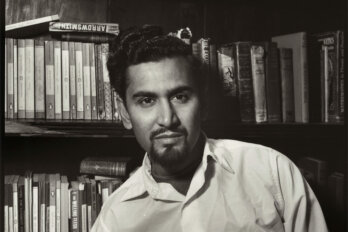Here is how Everyman ends his days: “Oh, the abandon of it,” he thinks, “and the smell of the salt water and the scorching sun!” Everyman is recalling the seashore from a hospital operating table, and his memories are typically manic and conflicted : “Daylight, he thought, penetrating everywhere, day after summer day of that daylight blazing off a living sea…” But then comes the actual close, no less ebullient for its dividedness: “He went under feeling far from felled, anything but doomed, eager yet again to be fulfilled, but nonetheless, he never woke up. Cardiac arrest. He was no more, freed from being, entering into nowhere without even knowing it. Just as he’d feared from the start.”
In two recent novels about illness and death, Philip Roth has dramatized a literary stage exit and a cultural funeral. Both events marked the close of something in American writing and life equally. In life that thing, broadly, was the immigrant Jewish experience so defining for the millions who fled Eastern Europe and Russia in the half century preceding the Holocaust. In literature, it was the novelists who required eulogy. Whether child arrivals at Ellis Island or offspring of the Diaspora, they insisted on declaring the geographies of their New World lives and the psychology of their New World selves to be as representative of the unfolding American experience as the geographies and selves of Walt Whitman and Mark Twain had been a hundred years earlier.
Given the seventy-five-year-old Roth’s own stature within that generation, he could have summarized the intents and energies of Everyman and Exit Ghost with a Twain paraphrase: Saul Bellow is dead, so is Norman Mailer. And I’m not feeling very well myself.
Everyman opens, appropriately, with the eponymous main character’s funeral. He is mourned by his children and brother. His daughter uses her graveside soapbox to put the tiny New Jersey cemetery in context. Their great-grandfather had helped found it in 1888, part of an effort by various societies and congregations to have a place to bury their own in accordance with Jewish law and ritual. An arch over the gate had been inscribed in Hebrew, six-pointed stars at either end. On the graves could be found the languages of the Old World: Hebrew, Russian, German, and Hungarian.
Those early Jews were devout, their English broken but their Yiddish, like their faith, whole. Everyman’s parents ran a jewellery store, a solid Jewish business, and at the end of his life his father became devout, attending synagogue every day. Everyman himself “stopped taking Judaism seriously at thirteen.” Religion meant little to him, the old language even less, and his adulthood, rife with material prosperity and personal upheaval, proclaimed allegiance to his country’s lived values: “He was one of the millions of American men who were party to a divorce that broke up a family.” In the end, though, he still finds himself interred in a cemetery for his kind, one now neglected and forgotten. “Things have rotted and toppled over,” Everyman’s daughter says of the site, a stand-in for the trajectory of the immigrant story, “the gates are rusted, the locks are gone, there’s been vandalism.”
In 2007’s Exit Ghost, the toppling is aesthetic. “Reading/writing people,” an old woman complains, channeling a long-dead Jewish author, “we are finished, we are ghosts witnessing the end of a literary era.” Philip Roth’s alter ego for a quarter century and nine novels, Nathan Zuckerman, is likewise deathly ill. A recluse, he reappears in New York after eleven years to undergo a medical procedure. While in the city, he revisits ghosts of various descriptions, includ-ing his own roaring younger self. “These were my notables,” Zuckerman writes of the Mailer-Bellow crowd, “the intellectually exceptional American sons of immigrant Jewish housepainters and butchers and garment workers.” Struggling with the “emotional burden of having been raised by semiliterate, Yiddish-speaking parents whose immigrant limitations and meagre culture evoked ire and tenderness in equally crippling portions,” left those sons (and daughters, presumably) sharp and irascible, natural agitators and affronters.
For Nathan Zuckerman, it is a variety of New World Jew, and the accompanying literary sensibility, that is dying out. Gone are the transgressors, charting in book after book the pilgrim’s progress of their own profane, outsized selves in volatile relation to a twentieth-century America of equal size and, in a sense, profanity. Liberated into the American world with the pathologies of the ghetto and the collective trauma of the Holocaust pulsing through their veins, these figures — Bellow’s Herzog and Humboldt, Roth’s Zuckerman and Mickey Sabbath — were anxious and searching, often morally unhinged. Appetites were more than monstrous; they were holes that could never be filled. Tragedies, personal and public, were inevitable, the falls precipitous.
“The Jew at his most buoyant,” Nathan Zuckerman thinks, “capable of a calm relationship with nothing and no one.” He widens the pantheon to include singer Eddie Cantor, comedians Jerry Lewis and Lenny Bruce, and social critic Abbie Hoffman. Of late, however, these wild Jews, so dubbed by admirers of Isaac Babel’s touchstone short stories about the Odessa underworld of the early twentieth century, have been supplanted by those of “mild, reasonable” disposition — not the kind, for instance, to stand up at a performance of the emotionally manipulative stage version of the Anne Frank story, and, after the Nazis arrive at the apartment and can’t find the doomed Jewish girl, shout out, “Look in the attic! She’s hiding in the attic!”
Roth doesn’t literally kill off his alter ego in Exit Ghost — we leave the impotent novelist scribbling a fantasy about his involvement with a much younger woman — but he has publicly declared the series, and the character, complete. And the final stage direction for his phantom? He disintegrates. Inevitable, then, that the narrator of Roth’s newest novel, Indignation, a young American Jew attending college during the Korean War, is dead throughout, “beyond corporeal existence” at the age of just nineteen. Living creatures are few and far between in these meditations on autumnal fury and resignation.
The joke about Anne Frank belongs to Mordecai Richler’s 1989 novel Solomon Gursky Was Here. Richler’s standing among his American peers is complex. The Montrealer thought of himself as swimming the same turbulent waters as Bellow and Roth, and made jokes about the mid-to late-century “take-over” of American literature. “We need more Gentile novelists,” he cracked in an essay, “they should be encouraged…” For the most part, Richler, too, had scant patience for either the formal tenets of the Orthodox Judaism he had rejected as an adolescent, or its shtetl legends. Once settled into his major voice, starting with 1971’s St. Urbain’s Horseman — a process, not so incidentally, advanced by the revelation of Bellow’s Herzog — he was largely preoccupied with the roaring, outsized individual. (Roth was similarly galvanized by how Bellow’s 1964 masterpiece mediated, sentence by sentence, the conflicted North American Jewish experience.) He also had a literary agenda particular to the geography of the far-less-charted Canada, one explored most expansively in Solomon Gursky Was Here, a pioneering work about, in effect, pioneering work.
That said, toward the end of his career Richler made a striking gesture in the direction of his inheritance. His maternal grandfather was Yudel Rosenberg, a Hassidic rabbi renowned for his literary retellings, often closer to reinventions, of the classic golem tales from the mystical branch of Judaism known as Kabbalah. For decades, the grandson inserted into his work only fleeting references to the clay creature brought to life to serve as a protector of Jews in medieval Prague. But in 1994’s This Year in Jerusalem, a memoir about Israel, he included a translation of one of Rosenberg’s stories about the golem and his master, the Maharal. The tale, fourteen pages of deep Jewish belonging in the midst of almost three hundred pages of the usual rugged Richler individualism, is put forth without preamble or explanation. It is simply present, as if to signal that while the author could not possibly incorporate the material into his sense of himself as a North American Jew, he recognizes it as part of the puzzle. Richler might even have been bequeathing the golem to the next generation, which, being less compelled to disown such legacies, might find him helpful to its own narratives of identity.
Michael Chabon’s new essay collection, Maps and Legends, includes two pieces about the golem. It also references, indirectly, Mordecai Richler’s grandfather, one of the “liars and legend-tellers and romancers” responsible for the clay creature’s mythic stature. Chabon, born in 1963, has been a boy wonder of American literature since his 1988 debut, The Mysteries of Pittsburgh. His key novels of this decade, The Amazing Adventures of Kavalier and Clay and The Yiddish Policemen’s Union, are spectacular riots of language and imagery. They also mark direct engagements with dimensions of the Jewish experience only glanced at, often with ambivalence, by those earlier, intellectually exceptional sons of Galician emigrants.
In Kavalier and Clay, two Depression-era teenage Jews create superheroes who protect the vulnerable from harm. Their comic book creations, inspired in part by the golem, smash Nazi armies and crush supervillains — at least until America enters the war. In The Yiddish Policemen’s Union, Chabon reroutes twentieth-century history, saving the Jews from the Holocaust with the Alaskan Settlement Act of 1940. In this fantasy, millions of lives are spared. So is Yiddish, the “murdered language” of European Jewry.
Other engagements, listed by Chabon himself in Maps and Legends, include “Sherlock Holmes and the Holocaust, medieval Jewish freebooters, Passover Seders attended by protégés of forgotten Lovecraftian horror writers…” All such preoccupations are bannered under “my heritage — rights and privileges, duties and burdens — as a Jew and as a teller of Jewish stories.” How the golem legend figures into Chabon’s sense of himself as a teller of Jewish stories is typical.
The piece “Golems I Have Known” charts his sober appreciation. One of the essay’s subtitles, “A Trickster’s Memoir,” warns of the impending blurring of fancy and fact. Chabon claims he found a golem in a New York uncle’s basement as a boy, and, accidentally breaking off one of its toes, watched the creature open an eye, its “dull, wet gaze” falling upon him. He fled the “Golem of Flushing,” only to hear his Uncle Jack in the living room upstairs shout, “They killed King!” The date was April 4, 1968, and the dead monarch was Martin Luther King Jr., murdered by James Earl Ray.
Rioting in Harlem led to the immolation of the same uncle’s candy store. The sequence of events causes Chabon to wonder if the golem, angry at the loss of his toe, had sparked the catastrophe. It was the beginning, he reports, of a “bitter truth about golems.” They are the “expression of a wish,” and whether the wish is for peace and security, or strength and control, scarcely matters. “All the wishes, dark and light, of a suffering people” are created and let loose by these energies.
What energies, exactly? He summarizes them as “the joy and power of the Greater Creation.” Elsewhere, he aligns the golem story with the specific powers of language, especially in the ser-vice of spinning tales. “Enchantment, of course,” Chabon writes in “The Recipe for Life,” “is the work of language; of spell and spiel.” In the legend, the golem is brought to life by means of magic formulas, “one word at a time.” As such, a clay superhero from Kabbalah lore and the assassination of an American civil rights leader both naturally reside, via the powers invested in Michael Chabon through language and imagination, in what he dubs “the theme park in my brain.” Quite a park it is, too: big enough for a Yiddish-speaking Jewish homeland in Alaska, extravagantly imagined.
Maps and Legends recounts an early reviewer who complained of Chabon’s being too eager to please in his fiction. The reviewer even compared him to the notorious Roth, granting that while “Mr. Chabon’s parents may not appreciate my holding up Philip Roth as an example to their son,” the natural agitator and affronter could offer “crucial lessons.” Chabon confesses his niceness and doubts he can be anything, or anyone, else. But he also asserts that even “the nice Jewish boy” has a mazik, or devil, in him, the impulse to take on things “you know you must or ought not say, do, or write.” In the end, however, he seems to prefer the word “trickster” to “devil” to define his sensibility, a nod to the gap between those generations.
“I have never known anything resembling in the slightest the anti-Semitism that exiled my grandparents and great-grandparents,” Chabon writes, “with no hope (and by 1945 no possibility) of return, from lands in which my ancestors had lived for a thousand years.” Nor has he had to assert any rightful place for himself in American society as a Diaspora Jewish writer under the duress of those Holocaust pulses and ghetto pathologies. As a result, Chabon, along with such fellow travellers as Nathan Englander — whose 2007 novel The Ministry of Special Cases features Argentine Jews with names like Kaddish Poznan and Talmud Harry — has felt freer, if not actually obliged, to reconnect with the formal Judaism earlier authors had shed.
All literary skills and energies aside, the nature of Michael Chabon or Nathan Englander’s reconnection with this identity will be passive, a heritage explored because it is interesting — akin, perhaps, to how Irish Americans (and Irish Canadians) reclaim their roots. It is something the writer will need to imagine his way back into, using family lore and grainy photos. It will certainly never again be a visceral, inescapable point of view, a heightened, near-hysterical version of a cultural identity born of the crematoria. For Philip Roth, in contrast, as for Saul Bel-low and Mordecai Richler, the mazik had to rule over what they said and wrote. It was a different time and, in a real way, a different literature. It was the time, as Roth puts it in Exit Ghost, recalling a public performance by Norman Mailer, of conquistadors and high drama — “The Twilight of the Gods.”
Richler’s final novel, 1997’s Barney’s Version, which mentions the golem, anticipated by several years the slow extinction Philip Roth is presently charting in his own twilight books. Profane, scurrilous Barney Panofsky’s losing battle with Alzheimer’s costs him his own story; he falls into silence about ten pages from the end, leaving it to his son Michael to finish the tale. He winds up a ghost in the pages of the novel bearing his name. The likes of Panofsky, Richler infers — i.e., a sui generis mode of Jewish identity — can’t be transferred. With their aging, disintegrating bodies go their singular, fierce dispositions. “Your father,” an old Jew tells Michael Panofsky in the novel’s dying pages, “was one of your real wild Jews. A bonditt. A mazik. A devil. I could have sworn he was out of Odessa.”






